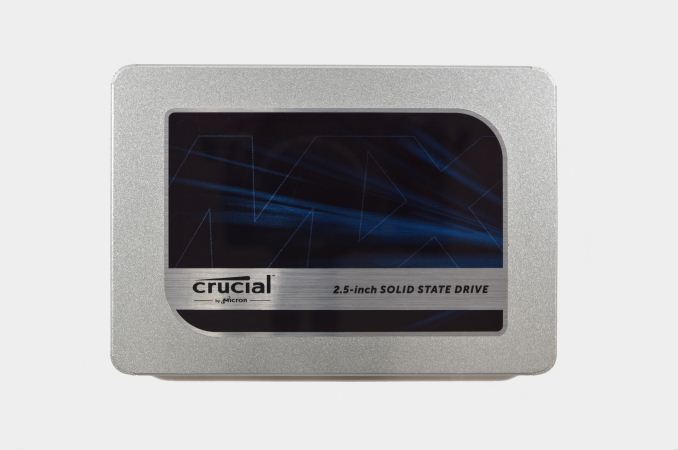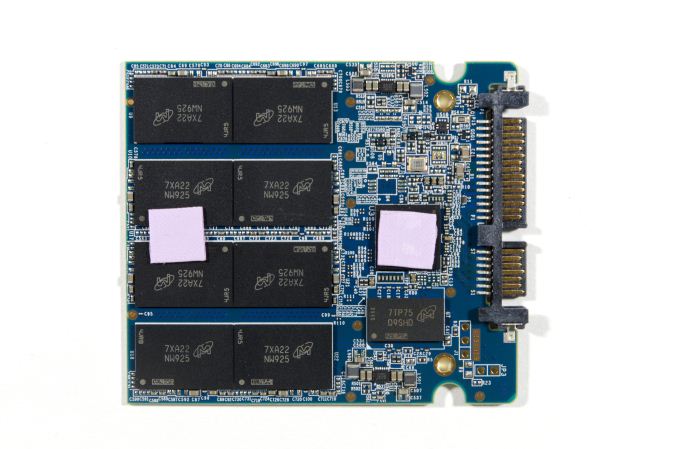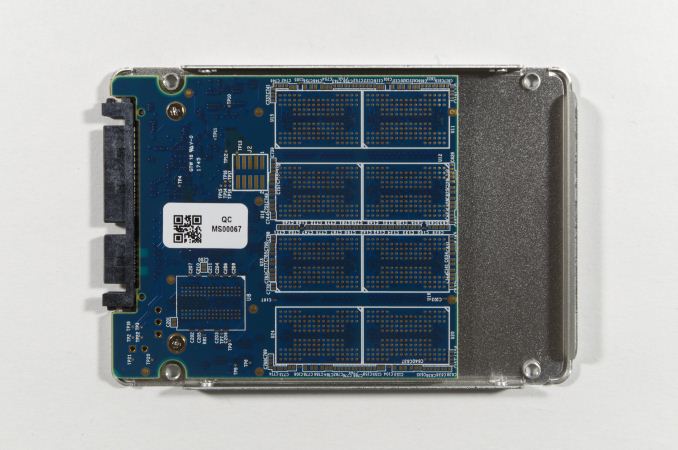The Crucial MX500 500GB SSD Review: A Second Look
by Billy Tallis on February 2, 2018 9:30 AM EST
In December, the 1TB Crucial MX500 impressed us with its combination of great performance for a SATA drive and an aggressive introductory price. Since then, Micron has launched the rest of the Crucial MX500 product line, and several other new SSDs have been announced. The most important new competitors aren't any of the many drives shown at CES, but the new Samsung 860 PRO and 860 EVO that launched last week. So far, we have only tested the premium Samsung 860 PRO, but it is clear that the improvements from Samsung's 64-layer 3D NAND process and their updated SATA SSD controller will affect where the 860 EVO stands. The handful of performance records set by the 1TB MX500 didn't last long.
The MX500 is the first Crucial drive based on Micron's 64-layer 3D TLC NAND, and is the second generation of Crucial's mainstream MX series to use TLC NAND instead of MLC NAND. The MX500 breaks from previous MX generations by using Silicon Motion's SM2258 controller instead of a Marvell controller, but all the usual features of the MX series are still present. This includes both TCG Opal encryption support and Crucial's partial power loss protection, features which are uncommon on mainstream or budget consumer SSDs. As usual for Crucial, the SLC write cache is dynamically sized based on how full the drive is.
The Crucial MX500 uses Micron's 256Gb 64L 3D TLC part and consequently returns to the standard drive capacities and overprovisioning ratios, instead of the unusual configurations caused by the 384Gb die capacity in the MX300's 32L 3D TLC. The slightly lower usable capacities of the MX500 than the MX300 means the new drives have slightly higher prices on a per-GB basis, but the MSRPs are still very competitive against current street prices for the competition.
Internally, the 500GB MX500 uses the same PCB as the larger models. The back side is entirely blank, with the 8 NAND package locations and one DRAM spot unpopulated. On the front, we find the eight of the same dual-die NAND packages used on the 1TB model, plus 512MB of DRAM, the SM2258 controller, and all the usual smaller components.
| Crucial MX500 Specifications | |||||
| Capacity | 250 GB | 500 GB | 1 TB | 2 TB | |
| Form Factors | 2.5", M.2 2280 single-sided | 2.5", M.2 2280 single-sided | 2.5", M.2 2280 double-sided | 2.5" | |
| Controller | Silicon Motion SM2258 | ||||
| NAND | Micron 256Gb 64-layer 3D TLC | ||||
| Sequential Read | 560 MB/s | ||||
| Sequential Write | 510 MB/s | ||||
| 4KB Random Read | 95k IOPS | ||||
| 4KB Random Write | 90k IOPS | ||||
| Dynamic Write Acceleration (SLC Caching) | Yes, dynamically sized | ||||
| DevSleep Power | 2 mW | 2 mW | 4 mW | 25 mW | |
| Slumber Power | 55 mW | 55 mW | 65 mW | 110 mW | |
| Max Power | 3.0 W | 4.0 W | 5.0 W | 6.0 W | |
| Encryption | TCG Opal 2.0 & IEEE-1667 (eDrive) | ||||
| Endurance | 100 TB | 180 TB | 360 TB | 700 TB | |
| Warranty | Five years | ||||
| MSRP | $79.99 | $139.99 | $259.99 | $499.99 | |
With capacities from 250GB to 2TB now available at MSRPs that are highly competitive, the Crucial MX500 is shaking up the SATA SSD market. Last year's budget SSDs need big price cuts, and even mainstream drives like the SanDisk Ultra 3D are having to drop in price. M.2 versions of the Crucial MX500 up to 1TB are also on the way, so ultrabook users will have most of the same upgrade options.
For this review, we are focusing on the 500GB Crucial MX500. This is a lower capacity than we initially tested, making it more affordable and a bit slower than the 1TB model. With a MSRP of $139.99 and current retail prices slightly lower, the 500GB Crucial MX500 should prove to be a very popular product. Testing at the 500GB capacity point gives us the opportunity to make more direct comparisons against some other drives in our collection, especially the Intel 545s and the Crucial BX300.
| AnandTech 2017 SSD Testbed | |
| CPU | Intel Xeon E3 1240 v5 |
| Motherboard | ASRock Fatal1ty E3V5 Performance Gaming/OC |
| Chipset | Intel C232 |
| Memory | 4x 8GB G.SKILL Ripjaws DDR4-2400 CL15 |
| Graphics | AMD Radeon HD 5450, 1920x1200@60Hz |
| Software | Windows 10 x64, version 1709 |
| Linux kernel version 4.14, fio version 3.1 | |
- Thanks to Intel for the Xeon E3 1240 v5 CPU
- Thanks to ASRock for the E3V5 Performance Gaming/OC
- Thanks to G.SKILL for the Ripjaws DDR4-2400 RAM
- Thanks to Corsair for the RM750 power supply, Carbide 200R case, and Hydro H60 CPU cooler
- Thanks to Quarch for the XLC Programmable Power Module and accessories
Our SSD testbed's software has been updated for 2018 with a fresh Windows installation that corrects some problems with The Destroyer that cropped up during testing of the 1TB MX500. The testbed is now running Windows 10 version 1709 for the ATSB tests instead of version 1703. So far, the benchmark results on 1709 appear comparable to those from 1703, so this review uses a mix of old and new results. It is likely that results for NVMe drives will not be as closely comparable between Windows versions due to the ongoing development of Microsoft's NVMe driver, so all NVMe drives will be re-tested before inclusion in new reviews (And all the SATA drives will be retested too over the next two months to take advantage of the higher resolution power measurements from our new Quarch XLC Programmable Power Module.) The Linux-based synthetic benchmarks in this review are all fresh results with an updated 4.14 kernel and fio version 3, which brings much higher resolution timing measurements.
Both operating systems on this testbed have not been patched for the Meltdown or Spectre vulnerabilities, and the motherboard firmware has not been updated to include new CPU microcode. Testing is underway on other machines to determine the performance impact of the mitigation strategies. The primary testbed will remain in its current software and hardware configuration for now as the OS and microcode programmers continue to work toward stable and complete fixes.












25 Comments
View All Comments
KarlKastor - Saturday, February 3, 2018 - link
I would like to see a review of old SSDs (Indlinx Barefoot, first Intel SSDs, Sandforce SSDs, crucial c300, Samsung 830 for example) and how they would compete against today's drives. The test parcours is much more detailed and challenging for the drives. Can older drives pass this test reasonable good enough or is an upgrade to a modern ssd an major improvement, besides of capacity.velanapontinha - Saturday, February 3, 2018 - link
^this^peevee - Monday, February 5, 2018 - link
Most decent SLC SATA drives should be fine, but there were terrible examples like Kingston V-series which were not much better than HDDs to begin with.But I'd like to see the tests too.
Dragonstongue - Thursday, June 21, 2018 - link
am using your charts to compare the previous results of the MX200 vs the "new" MX500, and most of the numbers and data have changed to show the MX200 as "better" than it once was, if properly tested, this should not have been shown as such.IMHO, if a drive at a specific time using a specific set of drivers etc had say a data rate of 217.85 (crucial MX200 500gb) why does this review "change" to show this same drive now being 235 (a gain of around 8%)
numbers should not be becoming "magically better" IMO, unless firmware was changed without notification, or tests were not run properly the first time around or something like that?
it is quite hard to do direct comparisons when your data does not agree with itself ^.^
MX500 is supposed to be "a fair bit quicker" in most things than MX200 or MX300 (around 18% for the 500gb models..20 odd % for the 1tb models) something is not agreeing with itself based on your data/numbers/review, this is troublesome to say the least, so I suppose my question in this regard is, how "factual" is the testing methodology being used, such as latency numbers (where the original data of MX200 read higher numbers in ms than this review does making this review appearing as if the mx200 is that much faster than it was previously (less latency)
and the power consumption was also higher previously whereas in this review it uses "less" power, the heck is up with this?
if one screwed up original testing methodology "I understand" but, if one just changes data willy nilly to suit vendors or make the older or newer stuff appear better than it actually is, screw that noise (we already have plenty enough companies/corps that do that crud daily..like Ngreedia, Apple, Intel, MSFT etc)
Just saying, had my eye on the MX500, my MX100 256gb has been working very well for me last 2.5-3 years or something like that (still at 99% life) MX200 500gb still snappy (though not quite as snappy as the MX100 for some reason and I have never had it "loaded" currently is at 92% life and yet is at least a 9 month newer drive, have not copied.deleted anywhere close to as much as it claims I have which is confusing...MX500 is supposed to have that much more endurance, but, if the MX200 seems to "chew" endurance more than it should, that is not a good thing.
I have taken all the steps I can to reduce writing to the drive (unless needed) have trim on since day 1 etc...
Anyways, compare the "original" MX200 data you reviewed dated may 22, 2015, with this review dated february 2, 2018, quite a difference in appearances from how so so the drive appeared (MX200) vs the way it "now" appears (seems like not quite a poor drive, though it never was crud drive)
https://www.anandtech.com/show/9258/crucial-mx200-...
https://www.anandtech.com/show/12263/the-crucial-m...
would say IMO, double check your info (past info) so you are not making silly mistakes if possible (I know no one is perfect by all means, but I highly doubt you keep hundreds of drives on hand so you can test them a year or 2 down the line, most review sites do not, so does this mean pulling numbers out of thin air?)
take care, love your site by all means, lots of good reading ^.^
dpjtpa - Friday, June 14, 2019 - link
This is definitely the option I will be purchasing soon